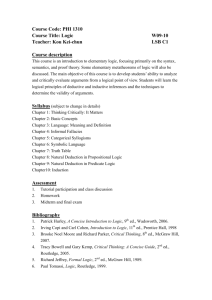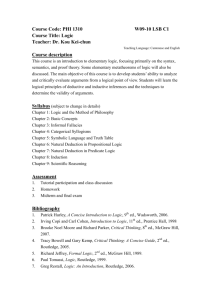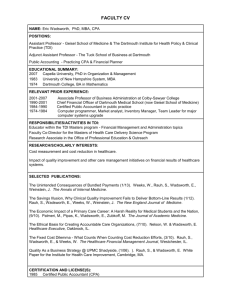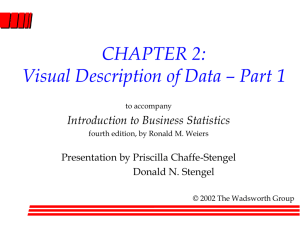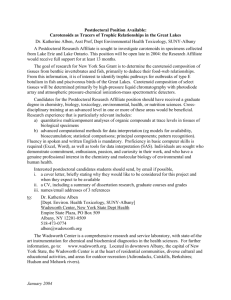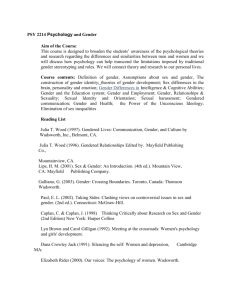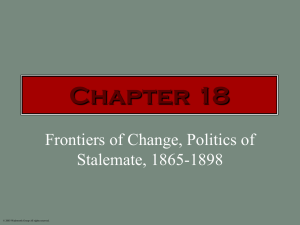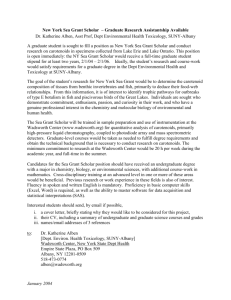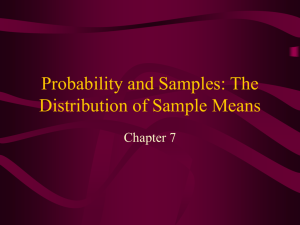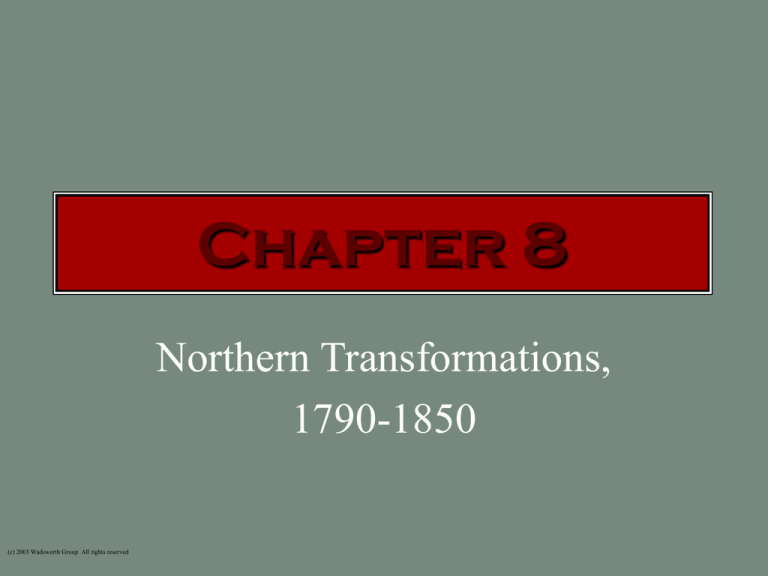
Chapter 8
Northern Transformations,
1790-1850
(c) 2003 Wadsworth Group All rights reserved
The Farmer’s Republic
• J. Hector St. John de Crèvecoeur: “bright
idea of property”
• Propertied independence and associated
social and political consequences
• Rural “competence”
(c) 2003 Wadsworth Group All rights reserved
Households
• Farm labor tasks: divided between the
sexes
• Men in fields
• Women in households
(c) 2003 Wadsworth Group All rights reserved
Rural Industry
• Children and wives of farmers worked in
household industries
• City merchants provided raw materials
• Country workers made and sold finished
goods, furniture, cloth, brooms, shoes
(c) 2003 Wadsworth Group All rights reserved
Neighbors
• Farmers involved in networks of neighborly
cooperation
• Neighboring farmers regularly worked for one
another, borrowed and traded
• Some cooperative events brought entire
communities together and fostered socializing
– Barn-raising
– Husking bees
• Barter economy
(c) 2003 Wadsworth Group All rights reserved
Inheritance
• Rural Republicanism
– Widespread farm ownership and rough equality of all
households
• Many fathers unable to leave enough to all offspring
• More and more young men left home
• Populations in old farming communities: older and
more female
• Populations in frontier settlements: younger and
male
(c) 2003 Wadsworth Group All rights reserved
Standards of Living
• 18th & 19th Centuries: improved living
standards
• Greater gap between prosperous farmers
and disinherited neighbors
• Typical housing: few rooms, many people
• Use of furniture and housewares spread
(c) 2003 Wadsworth Group All rights reserved
From Backcountry to Frontier
• 1790: America stretched almost 1500 miles
inland
• However, most Americans lived on Atlantic
• Settlers were pushing North and West
• Indians occupied most interior lands
(c) 2003 Wadsworth Group All rights reserved
The Destruction of the
Woodlands Indians
• Iroquois confined to NY & PA reservations
• Cherokees ceded 3/4ths of their land 1790
• Battle of Fallen Timbers (1794)
– Shawnee & Miami vs. “Mad” Anthony Wayne
• Treaty of Greenville
• Indian civilization in despair
(c) 2003 Wadsworth Group All rights reserved
The Failure of Cultural Renewal
• Alexander McGillivray
– Creeks
• Cherokee: Nation within a nation
• Tenskwatawa (The Prophet)
• Tecumseh
– William Henry Harrison
– Battle of Tippecanoe (1811)
(c) 2003 Wadsworth Group All rights reserved
The Backcountry, 1790-1815
• Many settlers melded Indian and white ways
– Legends of Davy Crockett
• Easterners shocked at frontier life
– Samuel Parsons “our white savages”
• 4 frontier states enter union by 1803: Vermont,
Kentucky, Tennessee, and Ohio
• Western backcountry settlers demand:
– Protection from the Indians
– Right to navigate Ohio and Mississippi Rivers
(c) 2003 Wadsworth Group All rights reserved
The Plantation South, 1790-1820:
Slavery and the Republic
• Slavery faced uncertain future
• Some began to free slaves
– Robert Carter and George Washington
• Thomas Jefferson
– Slavery is wrong, but can’t end in a society of free
whites and free blacks
(c) 2003 Wadsworth Group All rights reserved
The Recommitment to Slavery
• Industrial Revolution creates demand for
cotton
• long staple vs. short staple cotton
• Eli Whitney
– cotton “gin”
• Cotton: Lower South’s new cash crop
• Plantation slavery rejuvenated
(c) 2003 Wadsworth Group All rights reserved
Race, Gender, and Chesapeake
Labor
• Transition in economies meant changes in
types of labor imposed on slaves
• Typical tasks for male and female slaves
– Males: planting and raising crops, skilled
artisan trades, sometimes hired out to towns
– Females: household manufacturing (sewing,
candle-making), as well as farm work –
monotonous and unskilled
(c) 2003 Wadsworth Group All rights reserved
The Lowland Task System
• Slaves made up 80% of population in South
Carolina and Georgia
• Task system of assigning labor to slaves
• Slaves turned task system to their own uses
(c) 2003 Wadsworth Group All rights reserved
The Seaport Cities, 1790-1815
• 5 seaport communities exceeded
populations of 10,000:
–
–
–
–
–
Baltimore
Charleston
Boston
New York
Philadelphia
(c) 2003 Wadsworth Group All rights reserved
Commerce
• Seaport cities grew steadily during 18th
century
• Handled imports and exports
• 1800-1810: first time that urban population
outgrew the rural population
• Seaport merchants: financial infrastructure
of commercialization and industrialization
(c) 2003 Wadsworth Group All rights reserved
Poverty
• 1790-1820: unprecedented poverty and
depressed neighborhoods
• New York City: 6 severe epidemics of
yellow fever, 1791-1822
• Slums: evidence that monies created by
commerce were distributed
undemocratically
• Wealthiest 4% owned more than half the
wealth
(c) 2003 Wadsworth Group All rights reserved
The Status of Labor
• Artisans: half male work force in cities
• Republican virtue
• Jefferson: artisans are “the yeomanry of the
cities”
• Changes in technology displace skilled
artisans with semi-skilled wage labor
– Harder to live model of Republican virtue
(c) 2003 Wadsworth Group All rights reserved
The Withering of Patriarchal
Authority
• Patriarchal Republic becomes democracy
• Decline of paternal authority in households
• Many slaves and women welcomed the
changes
• By early 19th century: a new democratic
faith emerged
(c) 2003 Wadsworth Group All rights reserved
Paternal Power in Decline
• Ralph Waldo Emerson
• Alexis de Tocqueville
• Young people realized that they must make
their own way in the world
• Young men and women sought marriages
based on affection – rather than on property
• Marriage to unite individuals, not families
(c) 2003 Wadsworth Group All rights reserved
The Alcoholic Republic
• Traditionally, drinking not seen as threat to
social order
• Whiskey: farmer’s surplus of grain
– Cheaper than coffee, tea, imported rum
– Safer than water and milk
• Dramatic rise in alcohol consumption
• Increased drinking among young men living
away from families and old social controls
(c) 2003 Wadsworth Group All rights reserved
The Democratization of Print
• Rise in literacy
• Emergence of print culture catering to
popular tastes
• The Power of Sympathy
• Increase in literacy and printed matter
accelerated the democratizing process
(c) 2003 Wadsworth Group All rights reserved
Citizenship
• “universal” male suffrage
• Early 19th century suffrage reform
– Important steps from Republic of Founding Fathers to
mass democracy
– Political rights to propertyless white men
– Restrictions applied to African Americans and women
(c) 2003 Wadsworth Group All rights reserved
Republican Religion
• Founding Fathers: indifferent to organized
religion
– Washington: obligatory worship
– Jefferson: Deism
• No mention of God nor religion in the
Constitution
– Alexander Hamilton “we forgot”
(c) 2003 Wadsworth Group All rights reserved
The Decline of Established
Churches
•
•
•
•
•
1st Amendment
State support fades away
Episcopal
Congregational
Frontier settlements established with little
or no organized religion
(c) 2003 Wadsworth Group All rights reserved
The Rise of the Democratic Sects
• Methodists and Baptists: Camp meeting
revivalism
• Joseph Smith and Mormonism
• Religion a matter of the heart not head
• Francis Asbury and Methodist circuit riders
(c) 2003 Wadsworth Group All rights reserved
The Christianization of the White
South
• Evangelical Protestantism dominates white
South
• James McGready
• Camp meetings
– Cane Ridge, Kentucky (1801)
(c) 2003 Wadsworth Group All rights reserved
Evangelicals and Slavery
• Slavery: went from “sin” to acceptance
within Southern churches of
– Methodists
– Baptists
– Presbyterians
• After 1820, few Southern evangelicals
spoke out against slavery
(c) 2003 Wadsworth Group All rights reserved
The Beginnings of African
American Christianity
• Evangelical revivals convert many AfricanAmericans outside the deep South
• Independent black churches: Richard Allen
and Absalom Jones
(c) 2003 Wadsworth Group All rights reserved
Black Republicanism:
Gabriel’s Rebellion
• Example of Saint Dominque to Haiti
• Gabriel’s Rebellion in Virginia
– Republican rebellion more than slave revolt
– “Death or Liberty”
– Death
(c) 2003 Wadsworth Group All rights reserved
Conclusion
• 1790-1820: Transformation of American
republic
–
–
–
–
Doubled in size and population
Some classes gained, others lost
Catastrophic to non-white Americans
America more dependent on old world
economic centers
– Federalists and Jeffersonian Republicans
(c) 2003 Wadsworth Group All rights reserved

